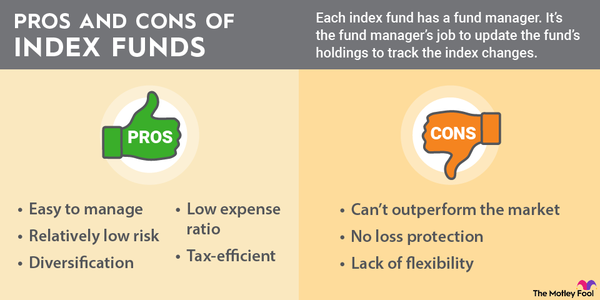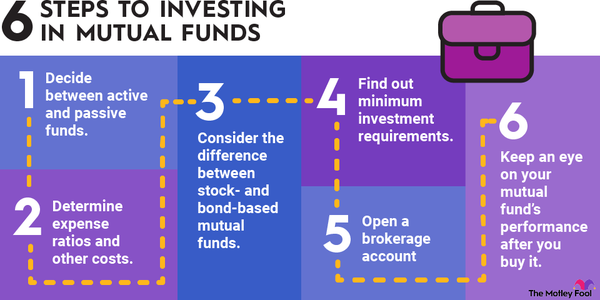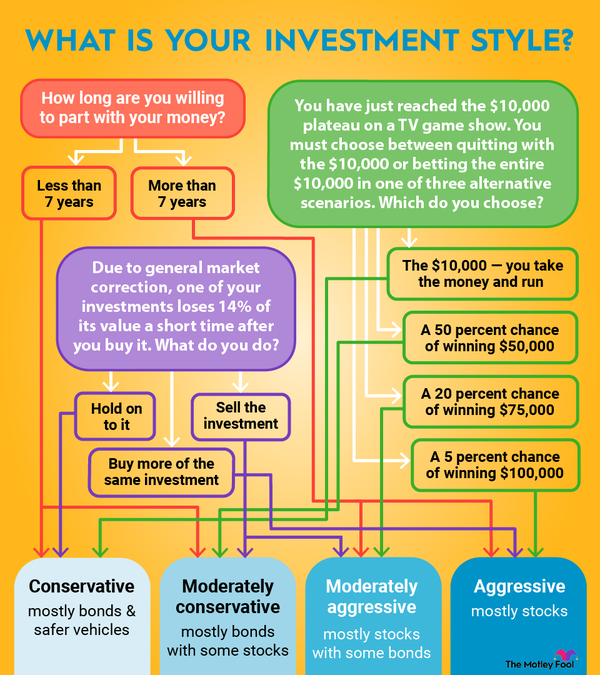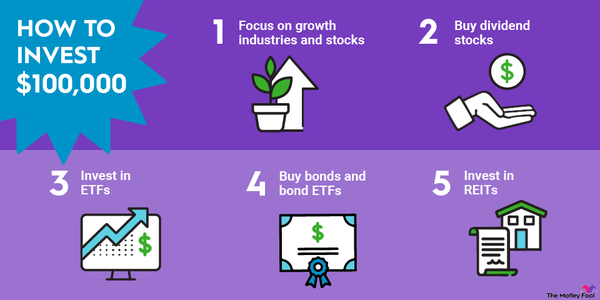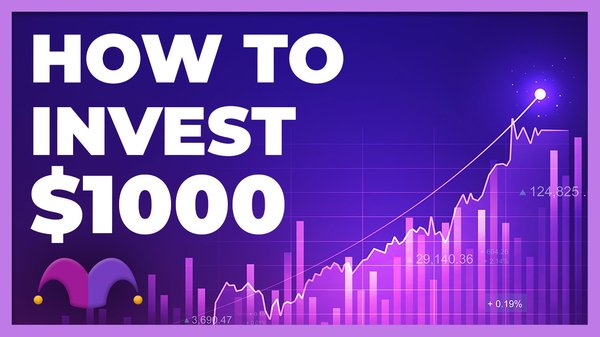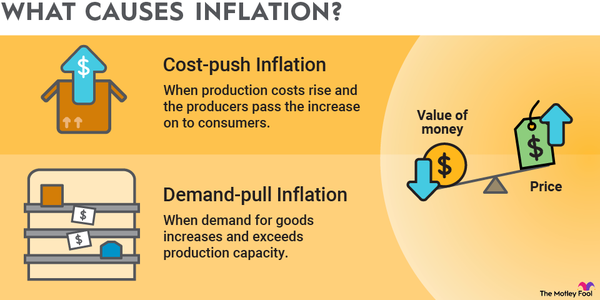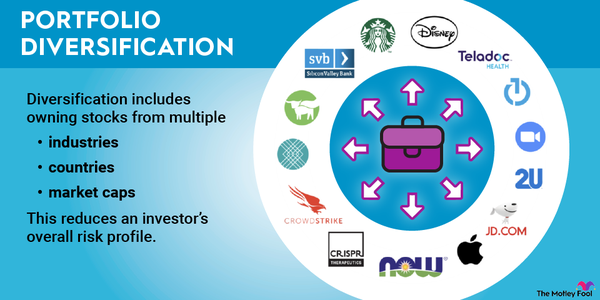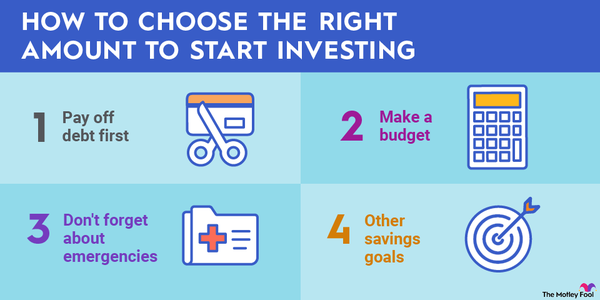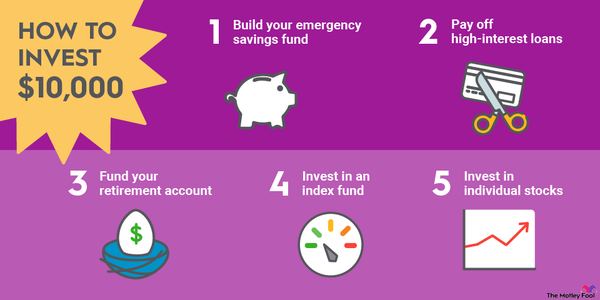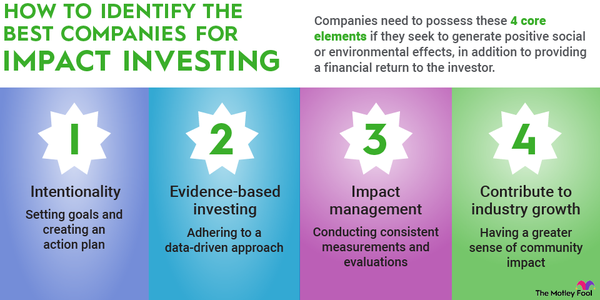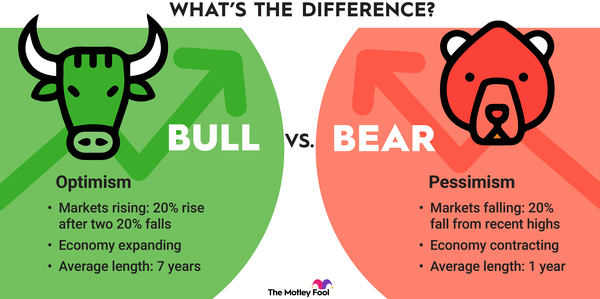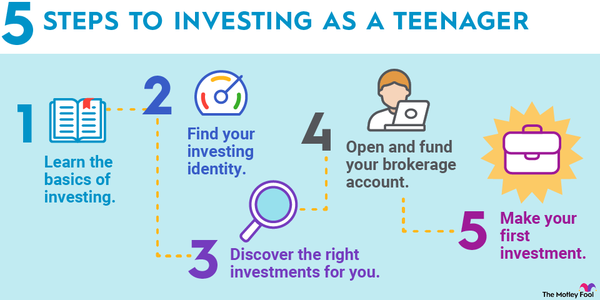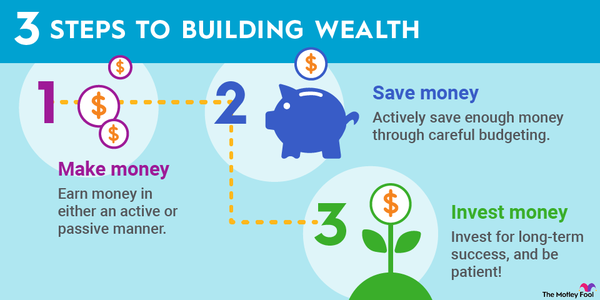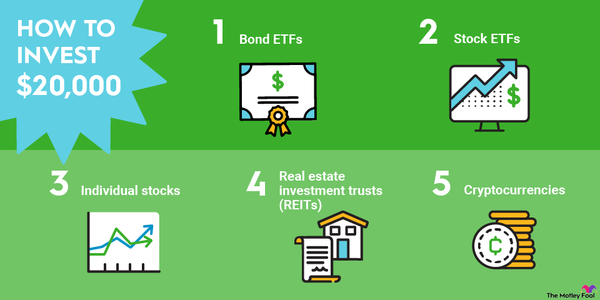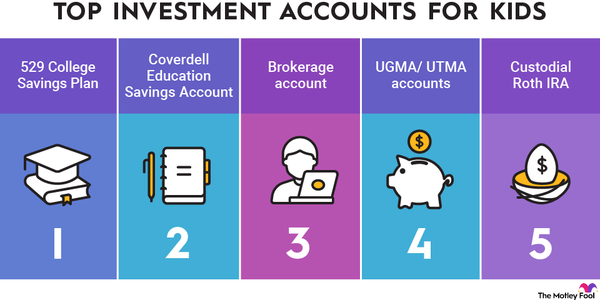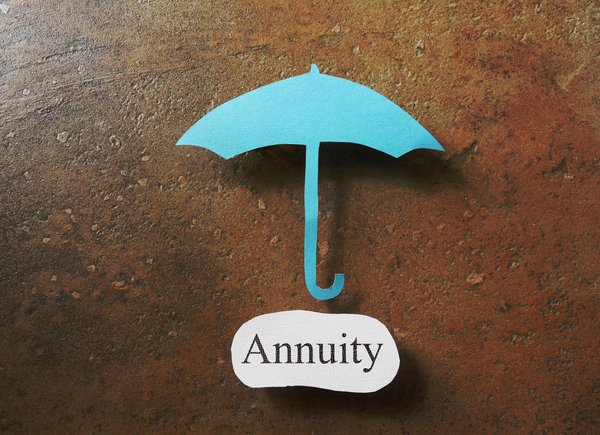If you have $50,000, or a large amount of money, sitting on the sidelines -- maybe in a checking account or a big bank savings account paying little interest -- putting it to work for you is a good idea. Don't know where to start? Here's some inspiration.
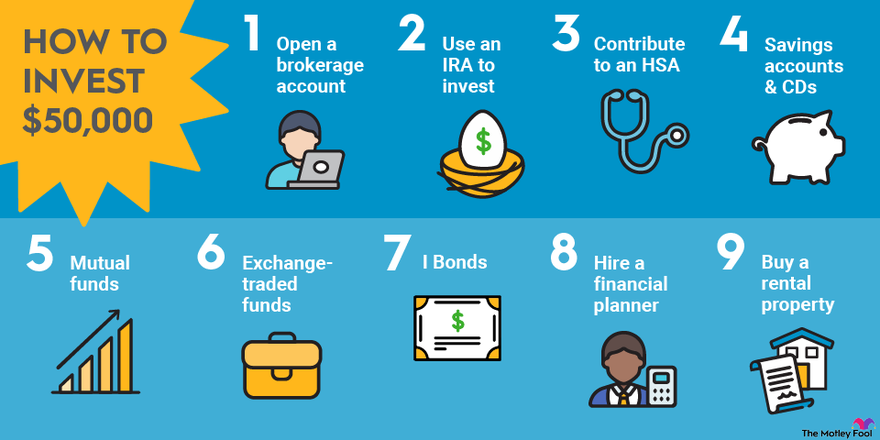
9 ways to invest $50,000
Nine ways to invest $50,000
The prospect of figuring out where to put a significant amount of money can seem scary. So, we put together nine ideas to help you plan your investment strategy.
1. Open a brokerage account
1. Open a brokerage account
You'll need a brokerage account if you want to invest in stocks, bonds, exchange-traded funds (ETFs), or mutual funds. In a nutshell, this is a special type of financial account that allows you to contribute money to buy and hold investments.
Buy-and-Hold Strategy
Plenty of brokerage firms offer accounts, and all have slightly different features. Some are rather minimalist and could be ideal for investors simply wanting a place to buy and sell stocks.
Others have features such as sophisticated trading platforms, educational resources, fully functional mobile apps, and much more. The best plan is to compare several of the top brokerages to see which one best meets your needs.
2. Invest in an IRA
2. Invest in an individual retirement account (IRA)
Technically, this is a form of brokerage account. An individual retirement account, or IRA, is a special type of brokerage account that you can open with the goal of saving and investing for retirement. You can only contribute a certain amount of money each year to an IRA -- the limit in 2023 is $6,500, or $7,500 if you're 50 or older. In 2024, the contribution limits are rising to $7,000 and $8,000, respectively.
This can be a great way to put some of your $50,000 to work. Once contributions are made, money in an IRA can be invested in virtually any stock, bond, or mutual fund you want. There are two main types of IRAs - traditional and Roth IRAs.
A traditional IRA allows you to make tax-deductible contributions, but any withdrawals from the account will be taxable income. A Roth IRA doesn't let you deduct your contributions, but qualifying withdrawals will be completely tax-free. It's worth noting that even if you have a retirement plan at work, such as a 401(k), you might still qualify for IRA contributions.
3. Contribute to an HSA
3. Contribute to a health savings account (HSA)
A health savings account, or HSA, is an overlooked investment tool. It is often confused with the other popular HSA, the flexible spending account (FSA), but it differs in some important ways.
First, unlike an FSA, money in an HSA can carry over from year to year. Contributions are tax-deductible, and money can be withdrawn with no taxes or penalties for qualified healthcare expenses.
Here's where it gets interesting. Money in an HSA can be invested, much like money in a 401(k). And tax-free withdrawals for healthcare expenses can be made at any time, regardless of the profits your investments have earned. Once you turn 65, you can withdraw money from your HSA for any reason, although nonhealthcare withdrawals are taxable income.
To contribute to an HSA, you'll need a high-deductible health insurance plan as defined by the government. The definition changes each year, so check out our guide to HSAs to explore these investment vehicles.
Annual HSA contributions are limited. For 2023, HSA contributions are limited to $3,850 for self-only coverage or $7,750 for family health coverage. So, you'll be unable to invest all $50,000 here. Even so, an HSA is certainly worth considering if you qualify.
4. Look into a savings account or CD
4. Look into savings accounts and CDs
Savings accounts and certificates of deposit (CDs) can be smart ways to protect your principal. For the first time in several years, investors can get a 4% or higher interest rate from savings.
Savings Account
The biggest drawback of savings accounts (other than their relatively low return potential) is that interest rates can fluctuate over time. Just because a savings account is paying 4% annually now doesn't mean that will be the case next year or even next month.
CDs allow you to lock in your interest rate for a specified period, and they typically pay a bit more than savings accounts. However, you're committing to keeping your money deposited until the CD matures -- or paying a penalty.
5. Buy mutual funds
5. Buy mutual funds
Mutual funds are investments that pool investors' money to buy a portfolio of stocks, bonds, and commodities, among other investments. The idea is that professional managers will allocate the portfolio on your behalf, taking the need for research and single-stock risk out of the equation.
Mutual funds can be active or passive index funds. In passive index funds, fund managers simply try to match the performance of an index. For example, a mutual fund that tracks the S&P 500 invests in the 500 companies in that index to match its performance over time. Alternatively, actively managed mutual funds aim to beat a benchmark index by allowing their managers to choose the fund's investments.
6. Check out exchange-traded funds
6. Exchange-traded funds
Exchange-traded funds are similar in nature to mutual funds, except they trade on major stock exchanges. Instead of choosing a specific dollar amount to invest, you choose how many shares of a particular ETF you want to buy.
Exchange-Traded Fund (ETF)
Most ETFs -- but not all -- are index funds, meaning they aim to match the performance of a specific stock (or bond) index. For example, the Vanguard S&P 500 ETF (VOO -0.41%) should match the performance of the S&P 500 over time.
Index funds tend to have low investment expenses, making them excellent choices for investors building a portfolio from scratch or who simply don't want the risk involved with investing in individual stocks.
7. Purchase I bonds
7. Purchase I bonds
One interesting way to put some of your $50,000 to work involves Series I savings bonds, commonly known as I bonds. I bonds are a special type of savings bond issued by the U.S. Treasury and designed to protect against inflation.
I bonds pay an interest rate that is a combination of a fixed rate, which stays the same for the life of the bond, and an inflation-based adjustment, which resets every six months. The fixed rate for new bonds issued from Nov. 2023 through April 2024 is 1.30%. Including the inflation adjustment, they guarantee a total annualized yield of 5.27% for the first six months.
The main reason we say you could put some of your money to work is that I bond purchases are capped annually at $10,000 per person. And that is one of the main drawbacks of investing in I bonds.
8. Hire a financial planner
8. Hire a financial planner
Investing can seem overwhelming, especially for people without the time and/or desire to research their choices. If you're in this group, there's nothing wrong with seeking professional help -- but there are some things to know beforehand.
First, know how your financial planner or advisor gets paid. Are they fee-only advisors, or do they make commissions on the products they sell?
Many financial advisors sell high-commission investments, such as insurance products, while fee-only advisors make the same fee income regardless of where they invest your money. The short answer is that fee-based advice is generally the best way to go, but it depends on the particular compensation structure.
Second, make sure your financial planner or advisor is a fiduciary. The simple definition is that a fiduciary is required to put your best interests ahead of theirs (this ties back into the high-commission investment products mentioned earlier).

9. Buy a rental property
9. Buy a rental property
Being a landlord isn't right for everyone. Even if you hire a property manager -- quite frankly, the best move for most investors -- owning rental properties is a more hands-on investment than stocks, ETFs, and most other choices.
That said, there is significant wealth creation potential with real estate investments. A rental property can generate rental income, and the value of the property is likely to increase over time.
And unlike stock market investing, you can responsibly use significant leverage to acquire real estate. Assuming a 20% down payment on a rental property, your $50,000 could have $250,000 of purchasing power, more than enough to buy your first investment property in many U.S. markets.
Before you decide to invest in real estate, be sure to do your homework. Know the amount to budget for things like vacancies and maintenance and how to evaluate the potential cash flow of prospective properties.
Those not interested in directly owning and renting a property may want to consider investing in real estate investment trusts (REITs), which have consistently outperformed stocks on a 20-to-50-year horizon while representing significantly less volatility than the S&P 500.
Related investing topics
There's no one-size-fits-all approach
An important takeaway is that there isn't an ideal investment strategy or asset allocation that works for everyone. For example, a retired person with $50,000 on the sidelines might want to put it into low-risk income instruments like CDs.
On the other hand, a 30-something with a similar amount of money might want to invest in something with a little more reward potential, such as stocks or real estate. The bottom line is that the right path for you might be a combination of the nine strategies listed here.
FAQs
How to invest $50,000 FAQs
What should I do if I have 50k to invest?
If you have $50,000 to invest, you have several options. The safest way to invest $50,000 would be to put it into a savings account or CD. However, you could also invest in stocks or real estate, start or add to a retirement account, and more. Your goals, risk tolerance, and time horizon until retirement will determine the right choice for you.
How much interest will $50,000 earn in a year?
The short answer is that it depends on what you invest in and how much yield you get. As a general guideline, every 1% yield in a savings account or CD will result in $500 in interest per year if you start with $50,000. So, if you invest $50,000 in a high-yield savings account with a 4% annual percentage yield (APY), you can expect to earn $2,000 annually, assuming the APY remains the same.
How can I turn $50,000 into more money?
The safest way to turn $50,000 into more money is to put it into an interest-bearing vehicle like a high-yield savings account, CD, or bond. But there are plenty of investment options if you have $50,000 to put to work. If you have a higher risk tolerance and a long time horizon, stocks or real estate could be the best way to turn your $50,000 into more money.
What is best to do with $50,000?
The best way to invest $50,000 depends on a few factors, including age, risk tolerance, and financial goals. But for most people, the best way to invest is some combination of fixed-income instruments (like bonds, CDs, or high-yield savings accounts) and stock-based investments that typically deliver the highest returns over long periods.











